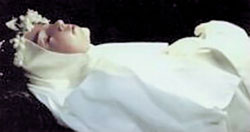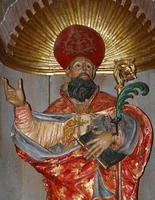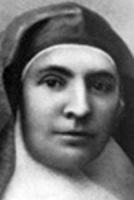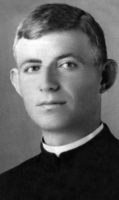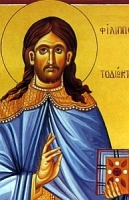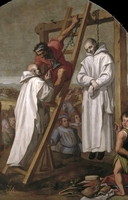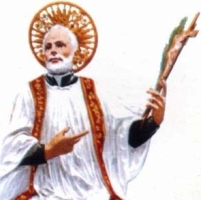Bl. Imelda
அருளாளர் இமெல்டா லம்பெர்ட்டினி
(Blessed Imelda Lambertini)
பிறப்பு: கி.பி. 1322
பொலோக்னா, இத்தாலி
(Bologna, Italy)
இறப்பு: மே 12, 1333 (வயது 11)
வால்டிபியேட்ரா, பொலோக்னா
(Valdipietra, Bologna)
ஏற்கும் சமயம்:
ரோமன் கத்தோலிக்க திருச்சபை
(Roman Catholic Church)
முக்திபேறு பட்டம் : கி.பி. 1826
திருத்தந்தை 12ம் லியோ
(Pope Leo XII)
நினைவுத் திருநாள்: மே 13
பாதுகாவல்: புதுநன்மை பெறுவோர்
அருளாளர் இமெல்டா, இத்தாலி (Italy) நாட்டின் பொலொக்னா (Bologna) எனும் நகரில், "இகானோ லம்பெர்ட்டினி" (Egano Lambertini) மற்றும் "காஸ்ட்ரோ கலுஸ்ஸி" (Castora Galuzzi) ஆகியோரின் ஒரே மகளாக கி.பி. 1322ம் ஆண்டு பிறந்தார்.
5 வயது நிறைந்த இமெல்டா, திருநற்கருணையைப் பெறுவதற்கு அளவு கடந்த ஆவல் கொண்டிருந்தார். ஆனால், அவர் வாழ்ந்த 14ம் நூற்றாண்டின் காலகட்டத்தில், திருநற்கருணையைப் பெறுவதற்கு, குறைந்தது 14 வயதாகிலும் நிறைந்திருக்க வேண்டும் என்ற விதிமுறை இருந்தது. ஒவ்வொரு நாளும், திருப்பலிக்கு முன்னர் அச்சிறுமி பங்குத் தந்தையிடம் தன் ஆவலை வெளியிட்டாலும், பங்குத் தந்தை அவரை காத்திருக்குமாறு கூறிவந்தார்.
தமது 9வது வயதில் சிறுமி இமெல்டா டொமினிக்கன் (Dominican community) துறவு மடத்தில் இணைந்தார். கி.பி. 1333ம் ஆண்டு இயேசுவின் விண்ணேற்றப் பெருவிழாவுக்கு முந்தின நாள், சிறுமி இமெல்டாவின் ஆவல் அற்புதமாக நிறைவேறியது. 10 வயதான சிறுமி இமெல்டா, அன்றையத் திருப்பலி முடிந்தபின், கோவிலில் தனித்து செபித்துக் கொண்டிருந்தார். திருப்பலிப் பீடத்தை ஒழுங்கு செய்துகொண்டிருந்த அருட்சகோதரி ஒருவர், இமெல்டாவுக்கு முன் நிகழ்ந்த ஓர் அற்புதத்தைக் கண்டார். அதாவது, சிறுமி இமெல்டாவுக்கு முன், திவ்ய நற்கருணை, ஒளிவடிவில் மேலிருந்து இறங்கி வந்தது.
இதைக் கண்ட அருட்சகோதரி, உடனடியாகச் சென்று பங்குத்தந்தையையும், ஏனைய அருட்சகோதரிகளையும் அழைத்துவந்தார். திருநற்கருணையைக் கண்டதும், பங்குத்தந்தை, திருப்பலி ஆடைகளை மீண்டும் அணிந்து வந்து, அந்தரத்தில் ஒளிவீசியபடி நின்ற அந்த நற்கருணையை கையில் ஏந்தி, அதை, சிறுமி இமெல்டாவுக்கு வழங்கினார். திருநற்கருணையைப் பெற்றுக்கொண்ட இமெல்டா, கண்களை மூடி, ஒரு புன்னகையுடன் செபித்தார். அவரைத் தொந்தரவு செய்யவேண்டாம் என்று மற்றவர்கள் ஆலயத்தை விட்டுச் சென்றனர்.
பல நிமிடங்கள் சென்று, துறவு இல்லத்தின் தலைமைச் சகோதரி, சிறுமி இமெல்டாவை அழைத்துச்செல்ல கோவிலுக்கு வந்தார். செபத்தில் ஆழ்ந்திருந்த சிறுமியின் வதனத்தில் மகிழ்ச்சி காணப்பட்டது. அருட்சகோதரி, சிறுமியின் பெயர் சொல்லி அழைத்தார். அவரிடம் அசைவு ஏதும் காணாததால், அவரது தோளில் மெலிதாக தட்டினார். உடனே சிறுமி நிலைகுலைந்து தரையில் வீழ்ந்தார். இமெல்டாவின் உயிர் பிரிந்திருந்தது.
சிறுமி இமெல்டா, போலோக்னா (Bologna) நகரிலுள்ள “சேன் சிகிஸ்மோன்டோ” (Church of San Sigismondo) ஆயலத்தில் அடக்கம் செய்யப்பட்டார்.
கி.பி. 1826ம் ஆண்டு, திருத்தந்தை 12ம் லியோ (Pope Leo XII), இச்சிறுமியை முக்திப்பேறு பெற்றவராக உயர்த்தினார்.
புதுநன்மை பெறும் அனைவருக்கும் இமெல்டா லம்பெர்த்தினி பாதுகாவலராக விளங்குகிறார்.
Feastday: May 13
The patroness of fervent first communion, Blessed Imelda, came from one of the oldest families in Bologna; her father was Count Igano Lambertini and her mother was Castora Galuzzi. Even as a tiny child she showed unusual piety, taking delight in prayer and slipping off to a quiet corner of the house, which she adorned with flowers and pictures to make it a little oratory. When she was nine, she was placed, at her own wish, in the Dominican convent in Val di Pietra, to be trained there by the nuns. Her disposition soon endeared her to all, while the zeal with which she entered all the religious life of the house greatly edified the nuns. Her special devotion was to the Eucharistic presence of Our Lord at Mass and in the tabernacle. To receive Our Lord in Holy Communion became the consuming desire of her heart, but the custom of the place and time had fixed twelve as the earliest age for a first communion. She would sometimes exclaim: "Tell me, can anyone receive Jesus into his heart and not die? "
When she was eleven years old she was present with the rest of the community at the Ascension Day Mass. All the others had received their communion: only Imelda was left unsatisfied. The nuns were preparing to leave the church when some of them were startled to see what appeared to be a Sacred Host hovering in the air above Imelda, as she knelt before the closed tabernacle absorbed in prayer. Quickly they attracted the attention of the priest who hurried forward with a paten on which to receive It. In the face of such a miracle he could not do otherwise than give to Imelda her first communion, which was also her last. For the rapture with which she received her Lord was so great that it broke her heart: she sank unconscious to the ground, and when loving hands upraised her, it was found that she was dead.
Imelda Lambertini (1322 – May 12, 1333) is the patroness of First Communicants.
Biography
Lambertini was born in 1322 in Bologna, the only child of Count Egano Lambertini[1] and Castora Galuzzi. Her parents were devout Catholics and were known for their charity and generosity to the underprivileged of Bologna. On her fifth birthday, she requested to receive Holy Eucharist; however the custom at the time was that children did not receive their First Holy Communion until age 14.
At age nine, she went to live with the Dominican nuns at Val di pietra, near Bologna.[2]
On May 12, 1333, the day of the vigil of the Ascension, she knelt in prayer and the "Light of the Host" was reportedly witnessed above her head by the Sacristan, who then fetched the priest so he could see. After seeing this miracle, the priest felt compelled to admit her to receiving the Eucharist. Immediately after receiving it, Lambertini went back to her seat, and decided to stay after mass and pray. Later when a nun came to get Lambertini for supper, she found Lambertini still kneeling with a smile on her face. The nun called her name, but she did not stir, so she lightly tapped Imelda on the shoulder, at which Imelda collapsed to the floor dead. Her remains are kept in Bologna at the Church of San Sigismondo, beneath the wax effigy of her likeness.
The cultus of this young Blessed has grown so popular that a confraternity for First Communicants has been established in her honor and the last Eucharistc Congress held in Bergamo passed a canonization.[3]
Beatification
Lambertini was beatified by Pope Leo XII in 1826.
St. John the Silent
Feastday: May 13
Birth: 452
Death: 558
Bishop of Colonia in Palestine and a hermit. Born in Nicopolis, Armenia, he established a monastery at the age of eighteen. Appointed a bishop at the age of twenty-eight, he spent nine years in his office before retiring to Jerusalem to embrace the eremitical life. Through a vision, he found his way to the monastery, or laura, of St. Sabas, asking to be walled up and living for seventy-five years as a silent recluse.
John the Silent of St. Sabbas' Monastery (Menologion of Basil II).jpg
Saint John the Silent (c. January 8, 454 – c. 558),[1] also known as St John the Hesychast (Greek: Ἅγιος Ἰωάννης ὁ Ἡσυχαστής), was a Christian saint known for living alone for seventy-six years. He was given the surname because of his affinity for recollection and silence. St. John's feast day is May 13 in the Latin Rite of the Roman Catholic Church, and December 3 in the Eastern Orthodox and Eastern Catholic Churches.[2]
Biography
John was born in 454 AD in Nicopolis, Armenia. He came from a family of mainly generals and governors. His parents died when he was 18 and he built a monastery where he stayed with 10 young monks. Under John's direction, they led a life of hard work and devotion.[3]
John built a reputation for leadership and sanctity, which led the archbishop of Sebaste to consecrate him bishop of Colonia in Armenia. He was only 28 at the time and had no desire for such a role. Nevertheless, he held the post of bishop for nine years. In 490, however, John went to Constantinople to secure the emperor’s intervention to quell a local persecution. Having accomplished his mission, he did not return to Colonia, but seeking to return to a life of seclusion went to Jerusalem.[4]
His biographer says that while John was praying one night, he saw a bright cross form in the air and heard a voice say to him, “If thou desirest to be saved, follow this light.” He saw the light move and point to the monastery of St. Sabas. At 38 years old he joined the monastery, which held 150 monks. Around 494, St. Sabas let John have a separate hermitage for uninterrupted contemplation. For five days a week he fasted and never left his cell but on Saturdays and Sundays he went to public Mass. After three years of this he was made the steward of the monastery.[3]
John had never told anyone he had been bishop, so after four years St. Sabas thought John was worthy to become a priest and presented him to the patriarch Elias of Jerusalem. They traveled to Calvary for the ordination but upon their arrival John requested a private audience with the patriarch. John said, “Holy Father, I have something to impart to you in private; after which, if you judge me worthy, I will receive holy orders.” They spoke in private after a promise of secrecy. “Father, I have been ordained bishop; but on account of the multitude of my sins have fled, and am come into this desert to wait the visit of the Lord.” The patriarch was startled but told St. Sabas, “I desire to be excused from ordaining this man, on account of some particulars he has revealed to me.”[3] St. Sabas was afraid John had committed a crime and after he prayed God revealed the truth to him. Sabas complained to John about keeping the secret from him and John wanted to leave the monastery. Sabas convinced him to stay by promising to keep his secret.[3] John stayed in his cell for four years, speaking to no one except the person who brought him necessities.
In 503 AD certain turbulent disciples forced St. Sabas to leave his monastery. St. John moved to a nearby wilderness where he spent six years in silence, conversing only with God and eating only wild roots and herbs. He remained in the desert six years. When St. Sabas returned to his community, he found John and convinced him to move back to the monastery. John had become used to speaking only with God and found only bitterness and emptiness in anything else. He treasured obscurity and humility so he wanted to live unknown to men but was unable to do so. He returned with St. Sabas and lived in his cell for forty years. During this time he did not turn people away who desired his instruction.[3]
One of these people was Cyril of Scythopolis who wrote about John's life. The two men first met when John was ninety and Cyril was sixteen. Cyril had asked him what to do with his life and John recommended he join the Laura of St. Euthymius but Cyril did not listen. Instead, he went to a small monastery on the bank of the River Jordan. He fell ill there and deeply regretted not listening to John. While there, John appeared to him in a dream and after scolding him for not obeying said that if he returned to St. Euthymius’ monastery, he would get well and find his salvation. The next day he did so and was well again.[3] John died in 558 AD at the age of 104.[5] He lived in solitude for 76 years, interrupted only for the 9 years he was bishop.
Our Lady of Fatima
தூய ஃபாத்திமா செபமாலை அன்னை
(Our Lady of the Holy Rosary of Fátima)
திருவிழா நாள்: மே 13
தூய ஃபாத்திமா அன்னை என்ற பெயர், போர்ச்சுக்கல் நாட்டின் ஃபாத்திமா நகரில், கி.பி. 1917ம் ஆண்டு, மே மாதம், 13ம் நாள் முதல், 1917ம் ஆண்டு, அக்டோபர் மாதம், 13ம் நாள் வரை லூசியா சான்ட்டோஸ் (Lúcia Santos), ஜெசிந்தா (Jacinta), பிரான்சிஸ்கோ மார்ட்டோ (Francisco Marto) என்ற மூன்று சிறாருக்கு அன்னை மரியாள் காட்சி அளித்ததன் அடிப்படையில் அவருக்கு வழங்கப்படுகின்ற பெயராகும். இந்த உலகின் பல்வேறு இடங்களில் மரியன்னை அளித்த காட்சிகளில் சிறப்பு வாய்ந்ததாக ஃபாத்திமா நகர் காட்சியும் விளங்குகிறது. இரண்டாம் உலகப் போர், ரஷ்ய நாட்டின் மனமாற்றம் ஆகியவை பற்றி ஃபாத்திமா அன்னை வழங்கிய முன்னறிவிப்புகள் அப்படியே பலித்ததால், ஃபாத்திமா காட்சி மிகவும் பிரபலம் அடைந்தது. ஃபாத்திமா அன்னையின் திருவிழா மே மாதம், 13ம் தேதி கொண்டாடப்படுகிறது.
வானதூதரின் காட்சிகள்:
கி.பி. 1916ம் ஆண்டு வசந்த காலத்தில், போர்ச்சுக்கல் நாட்டின் ஃபாத்திமா பகுதியில் ஆடுகளை மேய்த்துக் கொண்டிருந்த சிறுவர்களான லூசியா சான்ட்டோஸ், ஜெசிந்தா மார்ட்டோ, பிரான்சிஸ்கோ மார்ட்டோ ஆகியோருக்கு முன்பாக ஒரு வானதூதர் தோன்றி, தன்னை சமாதானத்தின் தூதர் (The Angel of Peace) என்று அறிமுகம் செய்தார். மேலும் அவர், "நான் போர்ச்சுக்கல் நாட்டின் காவல் தூதர், நீங்கள் பாவிகளுக்காக செபிக்க வேண்டும்" என்றும் சிறார் மூவரிடமும் கூறினார்.
கி.பி. 1917ம் ஆண்டு, மே மாதம், 13ம் தேதி, சிறார் மூவர் முன்னும் மீண்டும் தோன்றிய அதே வானதூதர் கையில் தற்போது நற்கருணையை ஏந்தி இருந்தார். அவரது கையில் இரசக் கிண்ணமும், அதன் மேலே அந்தரத்தில் மிதந்தவாறு நற்கருணை அப்பமும் காட்சி அளித்தன. நற்கருணையில் பிரசன்னமாகி இருக்கும் இயேசு கிறிஸ்துவிடம் கூறுமாறு பின்வரும் செபத்தை வானதூதர் அவர்களுக்கு கற்றுக்கொடுத்தார்:
“என் கடவுளே,
நான் உம்மை விசுவசிக்கிறேன்,
நான் உம்மை ஆராதிக்கிறேன்,
நான் உம்மை நம்புகிறேன்,
நான் உம்மை நேசிக்கிறேன்.
உம்மை விசுவசிக்காதவர்களுக்காகவும்,
உம்மை ஆராதிக்காதவர்களுக்காகவும்,
உம்மை நம்பாதவர்களுக்காகவும்,
உம்மை நேசிக்காதவர்களுக்காகவும்
உம்மிடம் மன்னிப்பு கேட்கின்றேன்.”
இறுதியாக, “இயேசு மற்றும் அன்னை மரியாளின் இருதயங்கள் நம் மன்றாட்டுகளுக்குச் செவி கொடுக்கக் காத்திருக்கின்றன” என்று கூறி வானதூதர் அவர்கள் முன்னிருந்து மறைந்தார்.
மரியாளின் காட்சிகள்:
அந்த தூதர் மறைந்தவுடன் சிறிது நேரத்தில், சிறார்கள் ஆடு மேய்த்துக் கொண்டிருந்த கோவா டா இரியாவின் ஒரு புதர் செடியின் மீது ஒளிமயமான ஒரு மேகம் வந்து இறங்கியது. அந்த மேகத்தின் மேல் அன்னை மரியாள் தோன்றி காட்சி அளித்தார். லூசியா சான்ட்டோஸ், ஜெசிந்தா மார்ட்டோ, பிரான்சிஸ்கோ மார்ட்டோ ஆகிய மூன்று பேரும் அந்த காட்சியைக் கண்டனர்.
மரியன்னை அவர்களிடம், "நான் செபமாலை அன்னை" என்று தம்மை அறிமுகம் செய்து கொண்டார். மேலும், அந்த மூன்று சிறாரும், தொடர்ந்து ஒவ்வொரு மாதமும் 13ம் தேதி அதே இடத்திற்கு வர வேண்டும் என்று அன்னை கட்டளை இட்டார். ஜூலை 13ம் தேதி, அன்னை மரியாள் காட்சி அளித்தபோது சிறுவர்களுக்கு நரகத்தின் கொடிய வேதனைகளைக் காண்பித்தார். "பாவிகள் மனம் திரும்ப செப, தவ முயற்சிகளை மேற்கொள்ள வேண்டும்" என்றும் மரியன்னை அறிவுறுத்தினார்.
மக்கள் நரகத்தில் விழாமல் இருக்க, "ஓ என் இயேசுவே! எங்கள் பாவங்களை மன்னியும். நரக நெருப்பிலிருந்து எங்களை மீட்டருளும். எல்லாரையும் விண்ணகப் பாதையில் நடத்தியருளும். உமது இரக்கம் யாருக்கு அதிகம் தேவையோ, அவர்களுக்கு சிறப்பாக உதவி புரியும்" என்ற செபத்தை செபிக்குமாறு மரியாள் கற்றுக்கொடுத்தார். காட்சியை உறுதிப்படுத்தும் வகையில் அக்டோபர் மாதம், 13ம் தேதி, சூரியனில் ஓர் அதிசயம் நிகழும் என்றும் அவர் முன்னறிவித்தார்.
ஆகஸ்ட் மாதம், 13ம் தேதி, லூசியா, ஜெசிந்தா, பிரான்சிஸ்கோ மூவரும் அதிகாரிகளால் விசாரணைக்காக அழைத்துச் செல்லப்பட்டனர். எனவே அன்றைய தினத்துக்கு பதிலாக, மரியாளின் விண்ணேற்பு நாளான ஆகஸ்ட் மாதம், 15ம் தேதி, சிறார் மூவரும் அன்னையின் காட்சியைக் கண்டனர். மக்கள் பலரும் அன்னையின் அற்புதத்தைக் காண இச்சிறாரைப் பின்தொடர்ந்தனர்.
மேலும் அன்னை தமது காட்சிகளின்போது, மனிதரின் தீய நடத்தையையும், இறைவனின் கோபத்தையும் வெளிப்படுத்தினார். மரியாள் காட்சி அளித்த வேளையில் நிகழ்ந்து கொண்டிருந்த முதல் உலகப் போர் விரைவில் முடியப் போவதாகவும், மக்கள் தொடர்ந்து பாவம் செய்தால் அதைவிடக் கொடிய உலகப் போர் மூளும் என்றும் அன்னை எச்சரிக்கை செய்தார். வானில் காரணமின்றி தோன்றும் ஓர் ஒளியே அந்த போருக்கு அடையாளமாக இருக்கும் என மரியன்னை முன்னறிவிப்பு செய்தார்.
கிறிஸ்தவர்கள் செபித்தால் மக்களிடையே (குறிப்பாக ரஷ்யாவில்) மனமாற்றம் நிகழும் என்றும், கிறிஸ்துவை அறியாதவர்கள் விரைவில் மனம் திரும்புவார்கள் என்றும் அன்னை மரியாள் மொழிந்தார். தலை வணங்கி கடவுளிடம் மன்னிப்புக் கேட்குமாறும், கிறிஸ்துவின் திருச்சிலுவைமுன் மண்டியிட்டு செபிக்குமாறும் மரியன்னை அறிவுறுத்தினார். "இறுதி காலத்தில் மக்கள் கடவுளின் கட்டளைகளை மதிக்காமல் நடப்பர், மக்களிடையே மனக்கசப்பும் வெறுப்பும் நிலவும், மனிதர்கள் உலகையே அழிக்கும் பயங்கர ஆயுதங்களைக் கண்டுபிடிப்பர்" என்றும், "இயற்கை சக்திகளால் சிறிது சிறிதாக அழிவுகள் ஏற்பட கடவுள் அனுமதிப்பார். குளிர்ந்த இரவில் ஏற்படும் கொடிய நிலநடுக்கத்திற்கு பின் உலகத்தில் பேரழிவுகள் தொடங்கும், கடவுளுக்கு விருப்பமான மக்கள் மட்டுமே அதில் தப்பி பிழைப்பர்" என்றும் அன்னை மரியாள் கூறினார்.
கி.பி. 1917ம் ஆண்டு, அக்டோபர் மாதம், 13ம் தேதி, அன்னையின் காட்சியைக் காண சுமார் 70 ஆயிரம் பேர் கூடி இருந்ததாக நம்பப்படுகிறது. அப்போது வானில் வியத்தகு அதிசயங்கள் தோன்றின. வானில் இருந்து பல வண்ணங்கள் தோன்றி மக்கள் மேல் ஒளிர்ந்தன. பெரிய மழை பெய்த வேளையிலும் அன்னை மரியாள் காட்சி அளித்த புதரும் 3 சிறார்கள் இருந்த இடமும் மட்டும் உலர்ந்தே காணப்பட்டன. மக்கள் பலரும் அன்னை தோன்றிய ஒளிரும் மேகத்தைக் கண்டனர். அப்போது அவர் சிறாரிடம், "மக்கள் செபிக்க வேண்டும்; பாவத்தினால் கடவுளின் உள்ளத்தை புண்படுத்தக்கூடாது" என்று மிகவும் வலியுறுத்தி கூறினார். மக்களின் மனமாற்றத்திற்காக செபமாலை செபிக்கப்பட வேண்டுமென்றும், இறுதியில் தனது மாசற்ற இதயம் வெற்றி பெறும் என்றும் மரியன்னை மொழிந்தார்.
சூரியனில் அற்புதம் நிகழ்ந்தபோது, சூரியன் மக்களின் கண்களுக்கு குளிர்ந்த நிலவு போன்று தோன்றியது. அது பம்பரம் போல சுழன்றவாறு, சிறிது நேரம் அங்கும் இங்குமாக தள்ளாடியது. இவற்றை அங்கிருந்த அனைவரும் பார்த்தனர். இந்த செய்தி போர்ச்சுக்கல் நாட்டு பத்திரிகைகள் அனைத்திலும் நிழற்படங்களுடன் வெளிவந்தது.
மூன்று இரகசியங்கள்:
முதல் இரகசியம்:
அன்னை மரியாள் ஃபாத்திமாவில் காட்சி அளித்தபோது, மக்கள் பாவத்தில் இருந்து மனந்திரும்பவில்லை என்றால் மீண்டும் ஓர் உலகப் போர் தோன்றும் என்றும், காரணமின்றி இரவு வானில் தோன்றும் ஓர் ஒளியே அதற்கு அடையாளமாக இருக்கும் என்றும் கூறினார். அன்னை முன்னறிவித்த அந்த ஒளி, 1938 ஜனவரி 25ம் தேதி வானில் தோன்றி, பூமியின் வட அரைக்கோளம் முழுவதும் ஒளிர்ந்தது. அதைத் தொடர்ந்து இரண்டாம் உலகப் போர் மூண்டது.
இரண்டாம் இரகசியம்:
அன்னை மரியாள் ஃபாத்திமாவில் காட்சி அளித்தபோது ரஷ்யா தனது மாசற்ற இதயத்திற்கு ஒப்புக்கொடுக்கப்பட வேண்டுமென்றும், ரஷ்யா கம்யூனிசக் கொள்கைகளில் இருந்து மனந்திரும்ப கிறிஸ்தவர்கள் அனைவரும் செபிக்க வேண்டுமென்றும் கேட்டுக்கொண்டார். திருத்தந்தை 12ம் பயஸ் முதலில் உலகத்தையும், கி.பி. 1952ம் ஆண்டு, ஜூலை மாதம், 7ம் தேதி, 'சாக்ரோ வெர்ஜென்ட்டே' (Sacro Vergente) என்ற தனது திருத்தூது மடல் வழியாக ரஷ்யாவையும் மரியாளின் மாசற்ற இருதயத்துக்கு அர்ப்பணித்தார். கி.பி. 1984ம் ஆண்டு, திருத்தந்தை 2ம் ஜான் பவுல், உலகத்தை மீண்டும் மரியாளின் மாசற்ற இருதயத்துக்கு அர்ப்பணித்தார். 1990களில் ரஷ்யா கம்யூனிசக் கொள்கைகளில் இருந்து மனம் திரும்பியது.
மூன்றாம் இரகசியம்:
அன்னை மரியாள் ஃபாத்திமாவில் காட்சி அளித்தபோது, இறுதி காலத்தில் மக்கள் கடவுளை மறந்து தீய வழிகளில் ஆர்வமாக இருப்பார்கள் என்றும், தீவிரவாதமும், வன்முறைகளும், பயமும் அதிகரிக்கும் என்றும், கத்தோலிக்க திருச்சபையும் திருத்தந்தையும் அதிகம் துன்புற வேண்டியிருக்கும் என்றும், கடவுள் பல்வேறு துன்பங்களை உலகில் அனுமதிப்பார் என்றும், உண்மை கடவுள் மீது உறுதியான நம்பிக்கை கொள்வோர் அழிவில் இருந்து தங்களைக் காத்துக்கொள்வர் என்றும், இறுதியில் தமது மாசற்ற இருதயம் வெற்றிபெறும் என்றும் அறிவித்தார்.
இந்த இரகசியங்கள் லூசியா சான்ட்டோசின் குறிப்புகளின்படி, கத்தோலிக்க திருச்சபையால் வெளியிடப்பட்டன. இரகசியங்களின் செய்தி சில வேளைகளில் வேறுவிதமாகவும் கூறப்படுகிறது. இந்த மூன்று இரகசியங்களைத் தவிர மற்றும் சில செய்திகளையும் அன்னை வழங்கினார். ஜெசிந்தாவும், பிரான்சிஸ்கோவும் சிறு வயதிலேயே இறந்துவிடுவர் என்றும், தனது செய்தியைப் பரப்ப லூசியா பல ஆண்டுகள் உயிரோடு இருப்பார் என்றும் மரியன்னை முன்னறிவித்திருந்தார். அதுவும் அவ்வாறே நிகழ்ந்தது.
கி.பி. 1981ம் ஆண்டு, மே மாதம், 13ம் தேதி, ஃபாத்திமா அன்னையின் திருவிழா அன்று, திருத்தந்தை 2ம் ஜான் பவுல் "அலி ஆக்கா" என்ற துருக்கிய இளைஞனால் துப்பாக்கியால் சுடப்பட்டபோது, தான் அன்னையின் கரங்களால் பாதுகாக்கப்பட்டதை உணர்ந்ததாக அவர் கூறினார். அவரது உடலில் பாய்ந்த துப்பாக்கித் தோட்டா, பின்பு ஃபாத்திமா அன்னையின் கிரீடத்தில் பதிக்கப்பட்டது. திருத்தந்தை 2ம் ஜான் பவுல் துப்பாக்கியால் சுடப்பட்ட இந்த சம்பவம், ஃபாத்திமாவின் மூன்றாவது இரசியத்தின் நிறைவேறுதலாக கருதப்படுகிறது.
ஃபாத்திமா பேராலயம்:
லூசியா, ஜெசிந்தா, ஃபிரான்சிஸ் ஆகியோர் மரியாளின் காட்சிகளை கண்ட நாட்கள் முதலே, ஃபாத்திமா காட்சிகளின் உண்மைத் தன்மையை ஆய்வு செய்யும் பணியைத் திருச்சபை அதிகாரிகள் மேற்கொண்டு வந்தனர். மேலும், கி.பி. 1917ம் ஆண்டு, அக்டோபர் மாதம், 13ம் தேதி காட்சியின்போது, நிகழ்ந்த சூரியனின் அற்புதத்தை எழுபதாயிரம் மக்கள் கண்டது இந்த காட்சியின் உண்மைத்தன்மைக்கு மேலும் வலுசேர்த்தது. ஃபாத்திமா காட்சிகளுக்கு பிறகு, கத்தோலிக்க திருச்சபை மக்களிடையே புனித வாழ்வு மலர பல்வேறு செப, தவ முயற்சிகளை மேற்கொண்டது. செபமாலை செபிக்கும் ஆர்வத்தை கிறிஸ்தவர்களிடையே அதிகரித்தது.
பல்வேறு விசாரணைகளுக்கு பின்பு, கி.பி. 1930ம் ஆண்டு, அக்டோபர் மாதத்தில் ஃபாத்திமா காட்சிகளின் உண்மைத்தன்மை திருச்சபையால் உறுதிசெய்யப்பட்டது. திருத்தந்தை 11ம் பயஸ், ஃபாத்திமா அன்னையின் வணக்கத்திற்கு அனுமதி வழங்கினார். இதன் மூலம் ஃபாத்திமா நகர், அன்னை மரியாளின் பக்தர்கள் வந்து செல்லும் புனித இடமாக மாறியது.
அதன் பிறகு அன்னை மரியாள் காட்சி அளித்த புதரின் அருகில் மரியாளின் பெயரில் பெரிய ஆலயம் ஒன்று கட்டி எழுப்பப்பட்டது. வானதூதர் காட்சி அளித்த இடத்தில் நினைவு சிற்பமும், மரியன்னை காட்சி அளித்த இடத்தில் நினைவு சிற்றாலயமும் அமைக்கப்பட்டுள்ளன. ஆண்டுதோறும் உலகெங்கும் இருந்து இலட்சக்கணக்கான திருப்பயணிகள் ஃபாத்திமா அன்னை பேராலயத்தை நாடிச் செல்கின்றனர்.
திருத்தந்தை 2ம் ஜான் பவுல், ஃபாத்திமாவுக்கு மூன்றாவது முறையாக திருப்பயணம் மேற்கொண்டபோது, கி.பி. 2000ம் ஆண்டு, மே மாதம், 13ம் நாளன்று, ஜெசிந்தா மார்ட்டோ, பிரான்சிஸ்கோ மார்ட்டோ ஆகியோருக்கு அருளாளர் பட்டம் வழங்கினார். 2010ம் ஆண்டு, மே மாதம், 13ம் தேதி திருத்தந்தை பதினாறாம் பெனடிக்ட் ஃபாத்திமா பேராலயத்தை நேரில் தரிசித்து, அன்னை மரியாளிடம் செபித்தார்.
திருக்காட்சியாளர்களுக்கு புனிதர் பட்டம்:
ஃபாத்திமா செபமாலை அன்னையின் திருக்காட்சியாளர்களாகிய அருளாளர்கள் ஜசிந்தா மற்றும் ஃபிரான்சிஸ்கோ (Jacinta and Francisco) ஆகிய இருவரும் கி.பி. 2017ம் ஆண்டு, மே மாதம், பதின்மூன்றாம் தேதி திருத்தந்தை ஃபிரான்சிஸ் அவர்களால் ஃபாத்திமா அன்னை பேராலயத்தில் புனிதர்களாக அருட்பொழிவு செய்விக்கப்பட்டனர்.
Also known as
Lady of the Rosary (she called herself that when Lucia asked her name)
Article
Commemorates the apparition of the Blessed Virgin Mary to three children in Fatima, Portugal on the 13th of each month from May to October in 1917. Our Lady appeared to Lucia, age 9, Blessed Francisco Marto, age 8, and Blessed Jacinta Marto, age 6, while they were tending sheep; they described her as "a woman all in white, more brilliant than the sun", and her message was to do reparation for sins that offend God, and to pray constantly for the conversion of sinners. She asked for devotion to the Holy Trinity, and for praying the Rosary daily for world peace. Word spread, and by the final apparition on 13 October, 70,000 people showed up to witness the Lady and the sign that she had promised; they witnessed the sun make three circles and zigzag around in the sky.
Approved
13 October 1930
Our Lady of Help
Also known as
Our Lady of Succor
Profile
Devotion to the Blessed Virgin Mary under this title began in Palermo, Sicily in the 14th century, and has since spread throughout the Augustinians. It began when Father Nicola Bruno, who suffered from severe and long-term pains in his side, prayed to Our Lady for healing while meditating on a painting of Mary in which she used a stick or club to chase away the dragon and protect the infant Jesus; the artist was making refence to passages in Genesis and Revelations that referred to the eternal enmity between The Woman and the serpent. That night, Father Nicola received a vision of Mary and was healed. The painting received the title "Our Lady of Help", and the devotion began. Since 1804 the celebration has had its own liturgy.
Saint Cristanziano of Piceno
Also known as
• Christian
• Christian of Anzio
Profile
First person in the area of Ascoli Piceno, Italy to convert and be baptized by Saint Emidius who gave him the name Cristanziano. Emidius saw to Cristanziano’s education, and ordained him as a deacon; Cristanziano served as assistant to Saint Emidius until the bishop‘s martyrdom. Imprisoned, tortured and executed in the persecutions of Maxentius. Martyr.
Born
280 in Ascoli, Italy
Died
• beheaded on 13 May 310 in Ascoli, Italy
• most relics enshrined in the cathedral of Sant'Emidio in Ascoli Piceno
• some relics enshrined in a silver reliquary in Maltignano, Italy
Canonized
• Pre-Congregation
• an Apostolic Brief of Pope Pius VI in 1776 enriched the feast of Saint Christian with major indulgences for eight days (13-20 May)
Patronage
• against discord
• against hail (tradition says that he was about to be martyred, a hail storm began; it would have stopped the execution, but destroyed the crops and condemned the town to famine; Cristanziano waved his hand, the storm moved away, the town was saved, and the execution completed)
• against influenza
• against lightning
• against storms
• against war
• Agnone, Italy
• Casalciprano, Italy (possibly due to his association with Emidius as this town is prone to earthquakes)
• Maltignano, Italy
Blessed Gemma of Goriano
Also known as
• Gemma of Gordianum
• Emma of...
• The Virgin of Goriano Sicoli
Additional Memorial
11 – 13 May (pilgrimage from San Sebastiano dei Marsi to Goriano Sicoli, Italy)
Profile
Born to a poor but pious farm family, they all moved into the village of Goriano Sicoli, diocese of Sulmona, Italy to try to improve their finances. Gemma was orphaned while still a young girl when both parents died in an epidemic; she lived with relatives and worked as a shepherdess, using her time in the fields to pray. She was such a beautiful young woman that Count Ruggero of Celano courted her, but Gemma was drawn to religious life and turned him down. He was so impressed with her dedication to her vocation that he built her a cell next to the church of San Giovanni in Goriano Sicoli positioned so that she could see the altar during Mass, and could give spiritual guidance to any who asked. She lived as an anchoress for her remaining 42 years.
Born
c.1375 in San Sebastiano dei Marsi, Bisegna, Abruzzo, Italy
Died
• 13 May 1439 in Goriano Sicoli, Italy of natural causes
• miracles reported at her grave
• body found incorrupt when exhumed
• re-interred under the high altar of the church of San Giovanni in Goriano Sicoli
• re-interred in a new church dedicated to her in 1613
• re-interred in a new church dedicated to her in 1818
• during World War II, a soldier began storing ammunition in the church; a young woman appeared and told him "Go away, this is my house."; he went away
• later in the war the front line, and all the fighting that went with it, was about to run through Goriano Sicoli; the villagers prayed for the intervention of Sante Gemma; six foot of snow fell, and the armies avoided the town
Beatified
1890 by Pope Leo XIII (cultus confirmed)
Patronage
Goriano Sicoli, Italy
Saint Servatus of Tongres
Also known as
Servaas, Servatius, Servais
Profile
Bishop of Tongres (in the modern Belgium) for 37 years. Welcomed Saint Athanasius of Alexandria during his exile by the Arians. Worked to remove heretical bishop of Cologne, Germany in 346. Active at the Council of Rimini in 359. Prophesied the mid-5th century invasion of Gaul by the Huns.
Born
Armenian
Died
• 13 March 384 at Tongres, Belgium of fever
• initially interred at Tongres
• miracles reported at his tomb including that snow would not accumulate on it no matter how deep it was all around it
• relics translated to the Saint Servaas Basilica, Maastricht, province of Limburg, Netherlands when Tongres was sacked
Patronage
• against foot problems, leg problems or lameness
• against mice or rats
• against rheumatism
• for success
Saint Rolende of Gerpinnes
Also known as
Rolendis
Profile
Born a princess, the daughter of King Didier of the Lombards who was in exile after being defeated in battle by Blessed Charlemagne. Feeling a call to a life for God, she fled from an arranged marriage to Prince Oger of Scotland, and planned to enter the Sainte-Ursule convent in Cologne, Germany. However, she fell ill while en route, and died at Villers-Poterie. She was in the village long enough that the people learned her story and recognized her as a holy woman.
Born
8th century in northern Gaul (in modern France)
Died
• 774 in Villers-Poterie (in modern Belgium) of natural causes
• buried at the parish church in Gerpinnes, Belgium
• healing miracles were reported at her grave site, which soon became a place of pilgrimage
• relics disinterred and enshrined in the church crypt in May 1103 by Otbert, prince–bishop of Liège, Belgium
• for centuries there has been a procession of her relics through all the local hamlets that used to comprise the territory of the parish church in which they were enshrined
Patronage
Gerpinnes, Belgium
Saint André-Hubert Fournet
புனித.அந்திரேயா ஹூபர்ட் பேர்னெட் (St.Andreas Hubert Fairnet)
சபை நிறுவனர்
பிறப்பு
6 டிசம்பர், 1752
வியன்னா (Wien)
இறப்பு
13 மே 1834
லா பூய் (La Puye)
புனிதர் பட்டம்: 4 ஜூன் 1933
திருத்தந்தை பதினோராம் பயஸ்
அந்திரேயா ஹூபர்ட் தன் குழந்தை பருவத்தையும் இளமை பருவத்தையும் மிகவும் கஷ்டப்பட்டு கடந்துவந்தார். இதனால் அவரால் சரியான விதத்தில் கல்வி படிப்பை முடிக்க முடியாமல் போனது. இவர் சிறுவயதிலிருந்தே குருவாக வேண்டுமென்று ஆசைப்பட்டார். ஒருநாள் முதன்மைகுரு அந்திரேயாவின் ஊருக்கு, பங்கு ஆலயத்தை பார்வையிடவந்தார். அச்சமயத்தில் முதன்மைகுரு திருப்பலி நிறைவேற்றினார். அத்திருப்பலிக்கு அந்திரேயா பூசைஉதவி செய்தார். திருப்பலி முடிந்தபிறகு வீடு செல்வதற்காக ஆலயத்திலிருந்து அந்திரேயா வெளியே வந்தார். அப்போது ஆலயத்தின் முன் ஒருவர் பிச்சை எடுத்துக் கொண்டிருந்தார். அவர் பெரிய பணக்காரரிடம் பிச்சை போடும்படி கெஞ்சினார். ஆனால் உதவிசெய்ய அப்பணக்காரர் மறுத்துவிட்டார். இதனை கவனித்த அந்திரேயா அப்பிச்சைக்காரரை தன் வீட்டிற்கு அழைத்துஸ் சென்று தன்னிடம் உள்ளதையெல்லாம் அவருக்கு கொடுத்தார். இதனை கவனித்த முதன்மைகுரு தன் உடைகள் மற்றும் தன்னிடம் இருந்த எல்லாவற்றையும் அப்பிச்சைக்காரரிடம் கொடுத்துவிட்டு, அந்திரேயாவை தன்னுடன் வரும்படியாக அழைப்பு விடுத்து, அவரின் விருப்பத்திற்கிணங்க குருக்களின் இல்லத்திற்கு அழைத்து சென்றார்.
அந்திரேயா தான் ஓர் குருவாக வேண்டுமென்று தனது விருப்பத்தை முதன்மை குருவிடம் தெரிவித்தார். பின்னர் அவர் குரு மடத்தில் சேர்ந்து முறைப்படி கற்று குருவானார். அந்திரேயா ஓர் உயர்ந்த, பலனளிக்கும் நல்ல இறை ஊழியரானார். இவர் ஏழைகளில் ஒருவராக வாழ்ந்தார். அப்போது ஏழை மக்களுக்கு பணிசெய்ய பிரான்சு நாட்டிற்கு சென்றார். அங்கு பல ஏழை மக்களின் வாழ்வை உயர்த்தியபின் 1792 ஆம் ஆண்டு மீண்டும் ஸ்பெயின் நாட்டிற்குஸ் சென்றார். அப்போது யோகன்னா எலிசபெத்து என்பவரின் உதவியுடன் ஏழைக்காக ஓர் சபையை தொடங்கினார். இச்சபைக்கு "அந்திரேயாவின் சகோதரிகள்" (Sisters of Andreas) என்று பெயர் சூட்டினார். இச்சபையை அந்திரேயா அவர்களே 1820- 1832 வரை தலைவராக பொறுப்பேற்று வழிநடத்தினார். சில ஆண்டுகள் கழித்து, இச்சபையானது பிரான்சு, இத்தாலி,ஸ்பெயின், கனடா என பல்வேறு நாடுகளுக்கு பரவியது. இச்சபையானது ஒரு சில ஆண்டுகளில் ஏழைகளுக்கென்று ஓர் மருத்துவமனையை கட்டியது. அதனைத் தொடர்ந்து நோயாளர்களை கவனிப்பதற்கென்று ஒரு செவிலிய பள்ளியையும் நிறுவியது. இப்பள்ளியையும், மருத்துவமனையையும் திருத்தந்தை ஒன்பதாம் பயஸ் அவர்கள் ஆசீர்வதித்து திறந்துவைத்தார்.
Also known as
• Andrew Hubert Fournet
• Andrea Uberto Fournet
Profile
Andrew had a strong religious upbringing, nagged by his mother to become a priest. Andrew resisted, and tried to study at Poitiers, but began leading a wild life. Out of school, his mother convinced him to stay with his uncle, a priest. The uncle's good example so moved Andrew that he turned his life around, returned to his studies, and felt the call to a vocation. Parish priest, assigned to Maille, France.
During the French Revolution, Andrew refused to take an oath that renounced the Church. He fled to Spain 1792 for five years, then returned to his parish, and was protected by his flock, celebrating the sacraments in secret. Andrew and Saint Jeanne Elizabeth Bichier des Ages, a local holy woman, founded the Sisters of the Cross (Sisters of Saint Andrew).
Born
6 December 1752 at Maille, France
Died
13 May 1834 at La Puye, Vienne, France of natural causes
Canonized
4 June 1933 by Pope Pius XI
Patronage
Sisters of the Cross (Sisters of Saint Andrew)
Blessed Julian of Norwich
Also known as
Juliana of Norwich
Profile
Almost nothing is known of her early life; we don't even know if she was from Norwich or chose to move there. Recluse under the direction of Benedictines in Norwich, England. Mystic, visionary, and writer. Her book, Revelations of Divine Love, which contains sixteen revelations she received while in an ecstatic trance, is still in print. She meditated on, spoke on, and wrote on the power of love of evil, Christ's Passion, and the nature of the Trinity. In her early 60s she shut herself in complete seclusion at Conisford, Norwich, and never left again.
Born
c.1342
Died
c.1423 of natural causes
Beatified
never formally beatified, but considered a "blessed" due to popular devotion
Blessed Gerard of Villamagna
Also known as
Gerard of Monza
Profile
Esquire to a knight. As a Crusader he was captured, later ransomed, and then returned to Italy. Franciscan tertiary. Lived the rest of his life as a hermit noted for his piety.
Born
1174 at Tuscany, Italy
Died
1242 of natural causes
Beatified
1833 by Pope Gregory XVI (cultus confirmed)
Patronage
• against bodily ills, illness or sickness
• sick people
Saint Euthymius the Illuminator
Also known as
• Euthymius Opplyseren
• Euthymius the Atonite
• Euthymius of Mount Athos
• Euthymius the Georgian
• Euthymius dell'Abasgian
• Eutimio...
Profile
Son of Saint John the Iberian. Held hostage for a while in Constantinople by the emperor. Helped his father build the Iviron Monastery on Mount Athos for Iberian monks. Abbot of the monastery c.1002 after his father's death. After serving 14 years, he resigned to concentrate on translation work. Translated the Bible, sixty writings of the Church Fathers, Bible commentaries, lives of the saints, liturigal books and other material into Iberian.
Born
in Iberia, Georgia
Died
13 May 1028 from injuries sustained when he fell from a mule while travelling
Saint Glyceria of Trajanopolis
Also known as
Glyceria of Heraclea
Profile
Roman maiden at Trajanopolis, Greece, and may have been the daughter of a Roman senator. Arrested for her faith during the persecutions of emperor Antoninus and the governor Sabinus, she managed to destroy a statue of Jupiter before being imprisoned, tortured and martyred.
Born
Rome, Italy
Died
thrown to wild animals but died from the effects of torture before they got to her, c.177 at Heraclea, Propontis (near modern Marmara Ereglisi, Turkey)
Blessed Magdalen Albrizzi
Also known as
Maddalena Albrici
Profile
Born to the Italian nobility. On the death of her parents, she became a nun at Brunate, Italy. As abbess she affiliated her house with the Augustinian hermits. Built a hospice in Como, Italy, and encouraged frequent Communion for everyone. She was known as a miracle worker, and for her gifts of healing and prophecy.
Born
c.1415 at Como, Italy
Died
13 May 1465 in Como, Italy of natural causes
Beatified
1907 by Pope Saint Pius X (cultus confirmed)
Saint Natalis of Milan
Also known as
Natale
Profile
Priest. Bishop of Milan, Italy for 14 months from 746 to 747. Governed during the difficult period when the Arian Lombards were converting to orthodox Christianity.
Died
• 13 May 747 of natural causes
• buried in the church of San Giorgio al Palazzo, a church he had built
Saint Argentea of Cordoba
Profile
Daughter of Omar ben Hafsun, Christian leader of anti-Ummayad forces in southern Iberia during the Moorish occupation. Following her mother's death, she devoted herself to prayer and a desire for religious life. She fled the Muslim forces to a monastery in Cordoba where she was caught, kept prisoner, and finally executed. Martyr.
Born
Bobastro, Spain
Died
13 May 931 in Cordoba, Spain
Saint Merewenna
Also known as
Merwenna, Merwinna
Additional Memorial
23 October (translation of relics)
Profile
Benedictine nun. First abbess of Rumsey convent in Hampshire after its restoration of King Edward the Peaceful in 967. Spiritual teacher of Saint Elfleda.
Died
• c.970 of natural causes
• interred in the convent church, Rumsey convent, Hampshire, England
Dedication of Saint Mary of the Martyrs
Profile
Commemorates and celebrates the dedication of the church of Saint Mary of the Martyrs, formerly a temple of all the pagan Roman gods called the Pantheon, in Rome, Italy by Pope Boniface IV in 609.
Saint Flavius of Chalon-sur-Saône
Also known as
Flaviano, Flavio
Profile
Late 6th century bishop of Chalon-sur-Saône, France. We know little about him, but he founded the Benedictine abbey of Saint Pierre di Chalon, and attended the councils of Mâcon in 581, Lyons in 583, Valence in 585, and Mâcon 585.
Died
c.593
Saint Agnes of Poitiers
Profile
Nun. Abbess of Holy Cross convent, a house of 200 sisters, Poitiers, France, assigned there by Saint Radegund. Introduced a rule given to her by Saint Caesarus of Arles. Friend of the poet Saint Venantius Fortunatus.
Died
588 of natural causes
Saint Vulfura of Cordoba
Profile
Vulfura had a dream in which he was told that in Cordoba, Spain he would meet a young woman with whom he would be martyred for his faith. Arriving in Cordoba, he met, was imprisoned with, and executed with Saint Argentea. Martyr.
Born
Gaul (modern France)
Died
937 in Cordoba, Spain
Saint Abban the Hermit
Also known as
Abben, Ewan
Profile
Hermit at Abingdon (formely Abbendun), Berkshire, England, which is named for him. Noted preacher. Founded a monastery in Berkshire. May be the earliest Irish saint.
Born
4th century Ireland
Died
c.520 of natural causes
Saint Anno of Verona
Also known as
• Annon of Verona
• Hanno of Verona
Profile
Bishop of Verona, Italy. Connected with the translation of the relics of Saint Firmus and Saint Rusticus.
Born
in Verona, Italy
Died
780 of natural causes
Saint Palladius II of Bourges
Also known as
Palladio
Profile
Born to a family of imperial Roman senatorial rank, Palladius became bishop of Bourges (in modern France) in the latter 6th century.
Saint Lucius of Constantinople
Profile
Priest. Imprisoned and tortured at Amphipolis and then Constantinople during the persecutions of Diocletian and Laudicius. Martyr.
Died
Constantinople
Blessed Faustino Chiari
Profile
15th century Franciscan friar who is remembered by the Order for his holiness, but no details of his life have survived.
Died
1467 in Brescia, Italy of natural causes
Saint Mael
Also known as
Mahel, Mel
Profile
Travelled with Saint Cadfan to Wales in the 6th century. Spent the rest of his life as a hermit on the isle of Bardsey, noted for his holiness and wisdom.
Born
Brittany, France
Saint Valerian of Auxerre
Profile
Third bishop of Auxerre, France. Fought Arianism.
Died
late 4th century
Saint Mucius
Profile
Priest. Martyred in the persecutions of Diocletian for overturning a pagan altar.
Born
at Byzantium
Died
304
Saint Maeldoid
Profile
6th–7th century monk and then abbot of the abbey of Mucnam, Castleblayney, County Monaghan, Ireland.
Born
Irish
Saint Onesimus of Soissons
Profile
Fifth bishop of Soissons, France.
Died
c.361
Martyrs of Alexandria
Profile
A group of Catholic Christians martyred in the church of Theonas, Alexandria, Egypt by order of the Arian Emperor Valens. Their names have not come down to us.
Died
in 372 in Alexandria, Egypt

